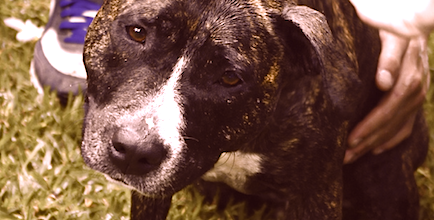Southern Dogs Going Yankee Through Dixie Dog Rescue
When shelters and rescues have extra space, they fill them with adoptable dogs from the South. Here’s a closer look at Dixie Dog Rescue.

Please bark along:
I wish I was in Dixie… hooray, hooray.
In Dixieland, I’ll take my stand
To live and die in Dixie.
But I’m nothin’ but a hound dog
Looking for a home
To Yankee lands I sure am bound
Go underground, old hound!
Have you heard of Dixie Dog Rescue? These folks transport dogs in Southern states on death row to areas up North, where they have homes waiting for them.
Southern shelters are filled with dogs, many highly adoptable, with no takers. Instead of being euthanized, some of these lucky dogs are brought North, where shelters are not filled and homes are abundant.
It’s often hard to find a fluffy-muffy or a beagely in a Northeast shelter that needs a home. There are pit and Am Staff mixes, pit Boxers, but few goldie poos and collie cuties.
No matter how you cut it, this discussion may sound offensive to my friends below the Mason-Dixon line and my bully dog rescue friends. Well, don’t raise the Confederate flags and the pro–pit bull rescue agendas yet. There are dogs in need of homes everywhere, irresponsible dog owners everywhere — and I support all the work people are doing to help stray pets anywhere! But truth be told, there are more kill shelters in the South, and they are bursting with a larger variety of dogs that need homes than in the Northeast.
Why are so many homeless dogs in the South? Call it cultural. Call it partially socioeconomic. Call it lack of education about spay and neuter. There is no one answer. In rural communities you have intact dogs roaming in warm weather and no safety net for animal care. This is a recipe for unwanted breeding.
The story of homeless dogs is finally improving in many areas of the country. Twenty years ago, in my state of Massachusetts, nearly 6,000 puppies came into the 5 MSPCA shelters. In 2004, 400 pups entered those same shelters, and the number of dogs being surrendered continues to decline. Spay and neuter education is the primary factor for fewer homeless dogs.
We still have a ton of work to do on cats, but that’s another article. So when a couple in suburban Boston, for instance, doesn’t want to buy a purebred dog but would rather adopt a homeless dog, they can be looking for weeks at their local shelter and not find a suitable pup.

Don’t leave your pet’s safety to chance
Sign up for Petful recall alerts today.

“Our Town” Animal Shelter
Most people have heard of or seen a production of Thornton Wilder’s famous American play Our Town. My local animal shelter was founded by Thornton Wilder’s sister, Janet Dakin, and I had the privilege of caring for some of her animals late in her life. The small Dakin Animal Shelter had a miracle befall them several years ago. Thanks to major mismanagement, a beautiful, state-of-the-art MSPCA animal shelter/hospital in Springfield, Mass., closed its doors. This was a shock to the community and very poor publicity for the MSPCA.
The Dakin Animal Shelter raised enough money to buy the massive facility, complete with beautiful adoption facilities and umpteen dog runs. And guess what? There were not enough dogs to fill the runs. On any day, you could find some 75-pound, 2-year-old unruly cross, neutered late or not at all.
These dogs are difficult to train now, and hard to handle for, say, a single mother with two toddlers. The underground dog programs bring dogs that were to be killed in Tennessee or Mississippi, to Massachusetts, Connecticut and other states where adopters are waiting.
When Dixie dogs come to me for a free health check, they are happy, tails wagging, being hugged by their new 4-year-old brother boy — and my heart leaps. These pups might be dead if left in an overcrowded shelter.
Most Dixies have been living with a foster family for several weeks and have received good veterinary care before reaching their new family. But if you adopt a dog from a different climate, be aware of the common problems of that area, and have your new dog go in for a checkup soon after arrival.
The video below shows Jackson, one of the Dixie dogs. Then we’ll cover some common health issues:

Common Health Concerns
If you adopt a “Dixie dog,” here are some easily addressed health concerns to keep in mind.
1. Fleas and Mange
are prevalent in the South because of the extreme hot temperatures. Follow up with flea treatment if necessary and bring your new dog to your veterinarian, particularly if Dixieland is scratching or has skin lesions. There may need to be follow-up treatment for flea allergy dermatitis or sarcoptic mange. There’s an easy fix!
2. Heartworm Status and Tick Diseases
is prevalent in the South. All dogs are usually tested for heartworm before coming up North and are treated if positive. I recommend you recheck all Dixie dogs for heartworm and tick diseases with your vet.
I have had a few dogs that arrived heartworm-positive. It is possible that it was too early to diagnose the heartworms at the time of adoption. These dogs are usually young and healthy. Early diagnosis and treatment of heartworms is usually safe and effective.
Ehrlichia is a tick disease prevalent along the Gulf Coast. With early diagnosis, this is also highly treatable.
- Don’t Miss: What Is Tick Paralysis?
3. Spay/Neuter Status
All the Dixie dogs should be spayed or neutered before arriving at their new homes. Have your veterinarian check the incision if the surgery is recent. Older dogs or dogs who have had litters may have mammary development, and that is normal.
4. Intestinal Parasites
Again, all dogs have usually been treated for parasites, fleas, mange and other pesky issues, but bring a fresh stool sample to your vet once your Dixie dog is in your care. Many parasites can flourish in Southern temperatures (hookworms, whipworms) and may need follow-up treatment. Again, this is easy stuff to fix.
From personal experience, I have to say that most Dixie dogs have the greatest temperaments and make great additions to any family. I encourage everyone to look “in your own backyard” first and adopt any local dogs in need of a home — but if your search is getting frustrating, you may want to see who’s waiting for you in the heart of Dixie.







